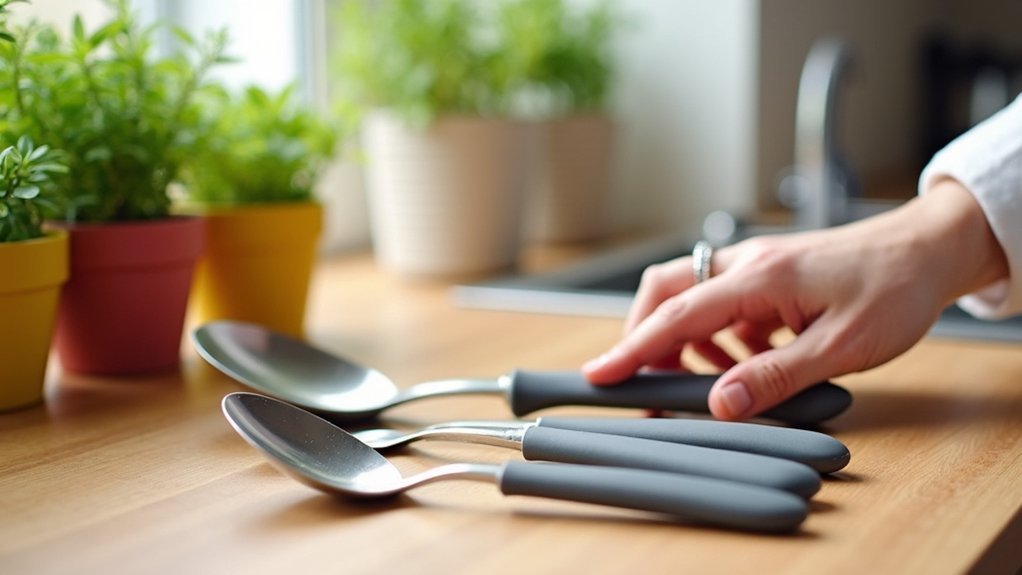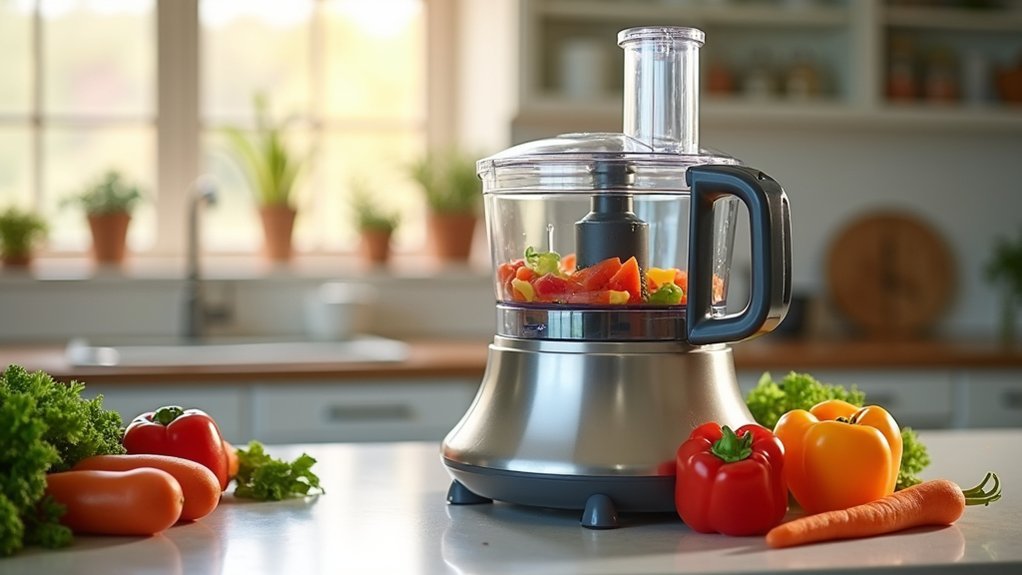Living with arthritis doesn’t mean giving up cooking independence. Key tools that reduce joint pain include wide-grip utensils, electric can openers, anti-slip cutting boards, ergonomic knives, one-touch jar openers, food processors, suction-based helpers, rocking knives, and lightweight cookware with helper handles. Smart kitchen organization also minimizes reaching and bending. These adaptive tools transform painful kitchen tasks into manageable experiences—and there’s a solution for every challenging movement you currently face.
Wide-Grip Utensils: A Game-Changer for Hand Mobility

Four key design features make wide-grip utensils a game-changer for those suffering from arthritis pain in the kitchen. The increased handle diameter reduces the need for tight gripping, allowing you to hold utensils more loosely while maintaining control.
Lightweight materials prevent hand fatigue during meal preparation, while contoured, non-slip handles distribute pressure evenly across your hand. The Easi-Grip Arthritis utensils exemplify this ergonomic design approach, offering comfortable solutions for those with limited dexterity.
Ingeniously designed with lightweight, contoured materials that prevent fatigue and distribute pressure where comfort matters most.
You’ll notice immediate benefits when using these specialized tools. The ergonomic design markedly decreases joint pressure, reducing pain during cooking tasks.
Rocking knives, wide-grip peelers, and adaptive cutlery all transform previously challenging activities into manageable ones. For many with limited hand mobility, these utensils restore independence in the kitchen—no more relying on others to prepare meals or struggling through painful food preparation.
Electric Can Openers That Do the Twisting for You
Electric can openers represent one of the most significant innovations for those struggling with arthritis pain in the kitchen. These devices eliminate the twisting motion that causes wrist strain and discomfort.
Look for models with side-cutting mechanisms like the Hamilton Beach Smooth Touch, which leaves smooth, safe edges. Magnetic lid holders prevent dropped lids, while stable bases provide security for those with hand tremors.
You’ll find options ranging from countertop models with easy-to-press levers to battery-powered handheld versions for maximum portability. The Cuisinart CCO-50N and Kitchen Mama openers offer single-touch operation ideal for limited dexterity. The Kitchen Mama model clings to the lid after cutting, preventing messy spills that could cause additional pain when cleaning up.
Unlike manual openers, electric versions reduce physical effort, improve safety, and work efficiently with various can sizes—making them worth the countertop space they require.
Anti-Slip Cutting Boards: Safety and Stability While Chopping

Choosing an anti-slip cutting board may be one of the wisest investments you’ll make for arthritis-friendly cooking.
These specialized boards feature non-slip surfaces or rubber suction feet that keep them firmly in place, eliminating the need to continuously stabilize your work surface while chopping.
Many designs include raised edges that prevent food from sliding off, while some adaptive versions feature food spikes to hold items securely.
The Waterproof Cutting Boards come equipped with two aluminum spikes that effectively secure food during preparation, making slicing and dicing significantly easier for those with limited hand strength.
You’ll find options in various materials and sizes, from compact 7.5-inch squares to larger 11-inch models, with prices ranging from £7.49 for basic boards to $44.95 for feature-rich designs.
The stability these boards provide not only protects your joints by reducing strain but also improves safety and increases your independence in the kitchen.
Ergonomic Knives: How Proper Design Reduces Joint Strain
Shock-absorbing comfort grips on ergonomic knives cushion your hands from painful vibrations when cutting tough foods.
You’ll appreciate how precision blades require less downward pressure, allowing you to slice efficiently while minimizing joint strain. The ergonomically-shaped handles with contoured designs offer superior control and comfort for those with limited grip strength.
The weighted balance technology distributes the knife’s mass evenly throughout the handle and blade, reducing wrist fatigue during extended food preparation sessions.
Shock-absorbing Comfort Grips
For people with arthritis, comfort grips represent a revolutionary advancement in kitchen knife design.
These specialized handles feature materials like silicone, rubber, or foam that absorb the shock generated during chopping and cutting tasks, dramatically reducing strain on your painful joints. Many seniors find that these tools promote their continued wellness and independence, much like the wellness programs offered at luxury retirement communities.
You’ll notice these grips often have contoured shapes that fit naturally in your hand, distributing pressure more evenly across your palm.
Non-slip surfaces prevent your fingers from slipping while cutting, enhancing both safety and stability.
Many models offer adjustable grip diameters to accommodate different hand sizes and arthritis conditions.
Precision With Less Pressure
When arthritis pain flares up in your hands, the simple act of cutting vegetables can become a painful ordeal. That’s where ergonomic knives make all the difference.
Unlike traditional knives, these specially designed tools feature curved blades that enable a smooth rocking motion, reducing strain on your joints. You’ll notice the balanced weight distribution and non-slip handles require less pressure to make precise cuts. This means you can chop, slice, and dice with greater comfort and control.
The ergonomic grip fits naturally in your hand, minimizing finger and wrist pressure while maintaining stability. Many models offer customizable handles to accommodate different hand sizes and grip styles. Using these tools helps protect your interphalangeal joints which are commonly affected by arthritis in the hands.
Weighted Balance Technology
The secret behind effective ergonomic knives lies in their weighted balance technology. These specially designed handles provide stability that reduces tremors and strain on your arthritic joints, making cooking more manageable.
You’ll find that weighted knives require less grip pressure while offering greater control. The balanced design distributes weight evenly, minimizing fatigue during food preparation. T-handle, rolling, and upright handle options each offer unique benefits depending on your specific needs.
Materials matter too—softer, non-slip surfaces enhance your grip without requiring excessive force. Many of these knives feature grip foam for added comfort during use. This thoughtful combination of weight adjustment, ergonomic shape, and appropriate materials means you can cut with precision while protecting your joints.
The result? You’ll experience less pain and greater independence in the kitchen, even during extended cooking sessions.
One-Touch Jar Openers: Saying Goodbye to Painful Twists
You’ll find one-touch jar openers eliminate painful twisting motions, making jar opening effortless with just a single press.
These versatile tools work on multiple jar sizes, from small spice containers to large pasta sauce jars. People with aging hands and those suffering from arthritis find these tools especially beneficial as they promote independence in kitchen tasks.
Many models don’t require batteries, using simple mechanical leverage to break the vacuum seal without straining your hands.
Effortless Lid Removal
For people with arthritis, opening stubborn jar lids can transform a simple kitchen task into an excruciating challenge. One-touch jar openers eliminate this pain point with their electric or battery-powered operation that requires no twisting or gripping.
These devices feature adjustable clamps that securely hold various jar sizes while large, ergonomic buttons require minimal pressure to activate. Tools like the One Touch Robo Twist can open even tightly sealed jars with its powerful mechanism, making kitchen tasks accessible for those with significant hand weakness. You’ll appreciate how the auto-stop function prevents over-twisting and potential lid damage.
The compact design includes stabilizers that keep jars firmly in place during operation.
What makes these openers invaluable is their versatility—they work with everything from small jelly jars to large pasta sauce containers.
You’ll regain kitchen independence as these tools reduce joint inflammation and eliminate the painful motions that typically aggravate arthritic symptoms.
Multiple Jar Sizes
Versatility stands at the core of what makes one-touch jar openers truly liberating for arthritis sufferers. These devices accommodate everything from tiny spice jars to large pasta sauce containers, eliminating the need for multiple kitchen tools.
You’ll appreciate how these openers adjust automatically to different lid sizes, securing themselves firmly around each container. Whether you’re opening a narrow jelly jar or a wide pickle container, the universal design guarantees a stable grip and smooth operation.
This adaptability means you won’t struggle with specialty items that traditional methods can’t handle. The adjustable fit provides consistent performance across your pantry items, preventing spills and accidents that often occur when wrestling with tight lids manually.
With a one-touch opener, you’ll navigate your kitchen with newfound independence, regardless of the container sizes you encounter. Many electric jar openers use magnetic stability to hold lids securely while automatically doing the twisting work, completely eliminating strain on painful joints.
Battery-Free Options
While electric jar openers dominate the market, battery-free alternatives offer reliable assistance without the hassle of charging or replacement batteries.
These non-electric, one-touch jar openers can effectively grip lids, allowing you to remove them without painful twisting motions that aggravate arthritis symptoms.
You’ll find these manual devices equipped with ergonomic handles for secure gripping, even with limited hand strength.
Though they require some physical effort, they provide stability and control that many users prefer. The simple lever or gear mechanisms reduce strain on your hands and wrists while maintaining your kitchen independence.
Available in various designs at different price points, these tools are typically more affordable than their electric counterparts.
Users consistently report reduced pain during kitchen tasks, making these low-maintenance devices a practical investment for managing arthritis symptoms. Many find that using a non-slip mat under the jar further reduces the effort needed when operating these manual openers.
Lightweight Cookware With Helper Handles
Lightweight cookware with helper handles offers two critical advantages for those managing arthritis pain. These specially designed pots and pans reduce strain on your joints while providing better control during cooking tasks. Tramontina cookware features helper handles specifically designed to distribute weight evenly between both hands. Look for options made from aluminum or anodized materials that weigh under 3 pounds, especially in small to medium sizes (6-10 inches).
| Material | Benefits | Weight | Handle Features | Cleaning Ease |
|---|---|---|---|---|
| Aluminum | Extremely light | 1-2 lbs | Wide grips | Moderate |
| Anodized Aluminum | Durable, lightweight | 2-3 lbs | Silicone coating | Easy |
| Hard-Anodized | Scratch-resistant | 2-3 lbs | Ergonomic design | Easy |
| Porcelain Enamel | Arthritis-endorsed | 2-3 lbs | Helper handles | Very easy |
| Nonstick Coated | Reduced scrubbing | 1-2 lbs | Non-slip texture | Excellent |
The dual-handle design distributes weight evenly between both hands, reducing wrist strain and improving stability when moving hot cookware.
Food Processors: Eliminating Manual Chopping Strain

Food processors transform your kitchen routine by handling everything from chopping vegetables to blending sauces with minimal hand strain.
You’ll find numerous attachments designed specifically for arthritis sufferers, featuring enlarged grips and easy-lock mechanisms that don’t require excessive twisting or pressure.
These multi-purpose devices eliminate the repetitive motions that often trigger arthritis pain, allowing you to prepare meals with greater independence and comfort. Positioning your food processor within easy reach can significantly reduce the need for lifting and reaching that might exacerbate joint pain.
Multi-Purpose Chopping Magic
For those battling arthritis pain, a quality food processor represents one of the most transformative kitchen investments you’ll make.
These versatile machines eliminate the repetitive motions that aggravate inflamed joints when chopping, slicing, and shredding.
Today’s models feature ergonomic designs with intuitive controls and powerful motors that handle everything from soft herbs to hard nuts. You’ll conserve precious energy while still preparing nutrient-rich meals that support your arthritis management.
The benefits extend beyond pain reduction. Food processors help you consistently incorporate anti-inflammatory ingredients into your diet, particularly those found in Mediterranean cooking. Preparing meals rich in high live microbes may be especially beneficial for those with rheumatoid arthritis, as research suggests a negative correlation between dietary live microbe intake and RA occurrence.
With dishwasher-safe parts and safety features like non-slip bases, they’re designed for those with limited dexterity. By automating these challenging tasks, you’ll maintain independence in the kitchen without sacrificing your joint health.
Arthritis-Friendly Attachments
While food processors themselves revolutionize meal preparation, their specialized attachments truly transform the cooking experience for those with arthritis.
These purposeful add-ons greatly reduce joint strain while expanding your culinary capabilities.
Look for processors offering these arthritis-friendly options:
- Grating and slicing discs – Eliminate manual knife work when preparing vegetables, cheese, and meats.
- Dicing kits – Create perfectly uniform pieces without tedious hand cutting.
- Emulsification blades – Mix sauces and marinades without strenuous stirring.
Most attachments feature easy-lock mechanisms and dishwasher-safe components for effortless cleanup. Newer models offer adjustable slicing discs for varying thickness, which is particularly beneficial when preparing vegetables for stir fry dishes.
Brands like Cuisinart, Breville, and KitchenAid offer models with ergonomic designs, intuitive controls, and visual indicators—ensuring you’ll enjoy cooking independence despite arthritis limitations.
Suction-Based Kitchen Tools That Stay Put
Because arthritis often limits your grip strength and hand stability, suction-based kitchen tools can be game-changers in your culinary routine.
These devices secure firmly to clean, flat surfaces, creating a stable workspace that doesn’t shift during use.
Suction cup cheese graters exemplify this innovation, allowing you to grate ingredients without constantly gripping the tool. Simply attach the grater to your counter and guide food across it, reducing strain on painful joints. Many models feature interchangeable drums for different textures.
Beyond graters, you’ll find numerous kitchen tools with suction bases that minimize the physical effort required for cooking tasks. Washing dishes becomes significantly easier with suction cup tools that attach securely to sinks for more efficient cleaning. They’re particularly valuable during longer food preparation sessions, helping you maintain independence while preventing overexertion.
The stability these tools provide also enhances safety by preventing slips and falls.
Rocking Knives vs. Traditional Cutting Techniques

When you’re living with arthritis, the simple act of chopping vegetables can become a painful challenge. Rocking knives offer significant advantages over traditional cutting techniques by requiring less grip strength and reducing joint strain.
Unlike traditional knives that demand repetitive force and pressure, rocking knives feature curved blades that enable smooth cutting motions with minimal effort. Their ergonomic design distributes pressure evenly, making food preparation safer and more comfortable. Research has shown that specially designed knives like the DuoGlide offset slicer require significantly less pressure and force compared to standard kitchen knives.
Here’s why rocking knives excel for arthritis sufferers:
- Reduced Pain – The rocking motion requires less force, minimizing strain on arthritic joints.
- Enhanced Safety – Easier control means fewer accidents during food preparation.
- Ergonomic Grip – Specially designed handles accommodate limited grip strength and mobility.
Many occupational therapists recommend these adaptive tools as essential for maintaining kitchen independence.
Smart Kitchen Organization for Reduced Reaching and Bending
Organizing your kitchen strategically can dramatically reduce the physical strain on arthritic joints during meal preparation. By creating zones for specific tasks and placing frequently used items within easy reach, you’ll minimize painful movements.
| Zone Type | Storage Solution | Benefit |
|---|---|---|
| Prep Area | Pull-out organizers | Eliminates deep reaching |
| Cooking Zone | Magnetic strips for utensils | Keeps tools visible and accessible |
| Cleaning Station | Adjustable height surfaces | Reduces bending strain |
| Refrigeration | Lazy Susans for condiments | Makes items in back accessible |
| Pantry | Drawer dividers | Prevents rummaging through contents |
Consider installing elevated work surfaces and implementing smart storage solutions like pull-out racks. Keeping the kitchen clutter-free enhances accessibility and makes cooking tasks more manageable. Breaking kitchen tasks into manageable segments with ergonomic seating nearby allows you to pace activities and take breaks when joints signal fatigue.
Frequently Asked Questions
Can Arthritis-Friendly Kitchen Tools Be Covered by Insurance?
Insurance typically won’t cover arthritis-friendly kitchen tools as they’re considered convenience items. You’ll need to pay out-of-pocket, though you might use FSA/HSA funds or seek help from arthritis foundations instead.
How Often Should Arthritic Hands Rest During Cooking Tasks?
You’ll need to give your arthritic hands a 10-minute break every hour during cooking. Consider task segmentation and sitting while prepping. Don’t push through pain – listen to your body and rest accordingly.
Are There Kitchen Tools Specifically Designed for Rheumatoid Versus Osteoarthritis?
While most kitchen tools help both conditions, you’ll find tools with adjustable grips and automation better for rheumatoid arthritis, while lightweight options with padded handles work best for osteoarthritis. Both benefit from ergonomic designs.
What Kitchen Modifications Work Best for Wheelchair Users With Arthritis?
You’ll benefit from lowered countertops, wide aisles for wheelchair turning, lever faucets, open shelving, and accessible drawers. Add slip-resistant flooring and magnetic measuring tools to minimize hand strain while cooking independently.
How Do Arthritis-Friendly Kitchen Tools Differ Between Summer and Winter Use?
You’ll need lighter tools with cooling features in summer, while winter requires easy-grip cookware for hot foods. Year-round, you’ll benefit from ergonomic handles and multi-functional devices that reduce joint strain.
In Summary
By adding these specialized tools to your kitchen, you’ll transform cooking from a painful task to an enjoyable activity. You don’t need to compromise your independence or favorite recipes because of arthritis pain. With ergonomic designs and smart technology working for you, you’re gaining both freedom and confidence. Remember, investing in the right tools isn’t just about convenience—it’s about maintaining your quality of life.





Leave a Reply